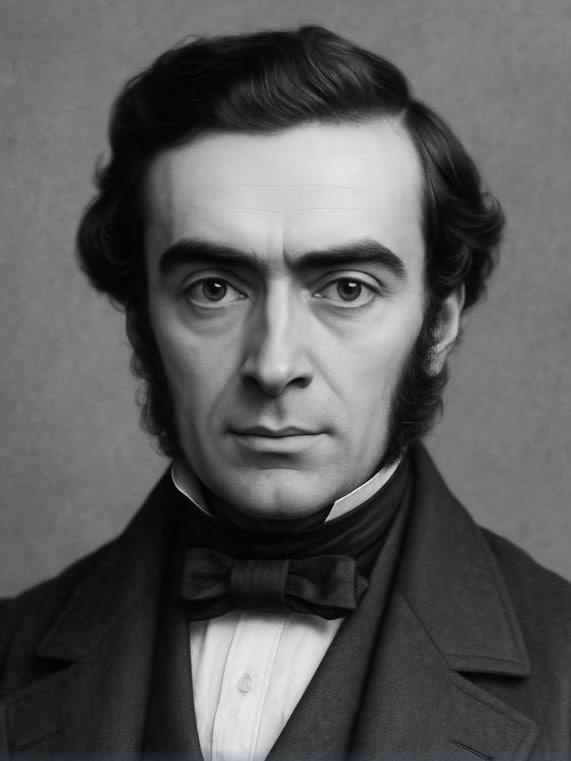George Budd

George Budd (1808-1882) was an English physician.
He published extensive research pertaining to gastroenterology and hepatology. His principal works were Disorders Resulting from Defective Nutriment (1842), Diseases of the Liver (1845), and Diseases of the Stomach (1855). Budd is eponymously associated with Budd-Chiari syndrome and Budd cirrhosis.
His time as a hospital ship physician formed a foundation for his works on the causes, treatment, and prevention of scurvy in sailors; descriptions of cholera among seamen; and his work on liver disease.
Biography
- Born February 23, 1808 in North Tawton, Devon; one of nine sons of surgeon Samuel Budd, seven of whom became doctors
- 1827-32 – Entered St John’s College, later moving to and graduating from Caius College, Cambridge. Completed clinical training in Paris and at Middlesex Hospital in London
- 1836 – Elected a Fellow of the Royal Society
- 1837-41 – Visiting physician to the Seaman’s Hospital Society hospital ship ‘Dreadnought’
- 1840 – Conferred a Doctor of Medicine in Cambridge
- 1840-67 – Professor of medicine at King’s College, London
- 1880 – Honorary fellow of Caius College, Cambridge, and King’s College, London
- 1863-1867 – retired from his academic and clinical roles
- Died March 14, 1882 in Barnstaple, England
Medical Eponyms
Budd–Chiari syndrome (1845)
Obstruction of the hepatic venous outflow
1845 – Budd published a case series of three patients who had hepatic vein thrombosis in his work ‘On Diseases of the Liver‘, in the chapter on inflammation of the hepatic and portal veins.
Two cases who died of phlebitis following leg amputations had multiple intra-hepatic abscesses, and thrombosis of the hepatic veins. The third case had hepatic, splenic, pericardial, and pleural adhesions which Budd attributed to considerable alcohol consumption. Budd postulated that hepatic vein thrombosis was due to inflammation of the veins, most commonly due to infection, and rarely from alcoholism. He also included a previous case Lambron described in 1842.
Budd cirrhosis
Chronic hepatomegaly secondary to ‘intestinal intoxication‘
Key Medical Attributions
Nutritional deficiencies – Budd postulated that dietary deficiencies were the cause of several diseases he had observed among sailors in his lectures ‘Disorders Resulting from Defective Nutriment‘, later published in the London Medical Gazette in 1842. His ideas were more than 50 years before the definitive vitamin deficiencies were identified.
Scurvy – Budd postulated that prolonged abstinence from fresh fruit and vegetables, or their preserved juices, were the sole cause. Hence, he suggested that scurvy would be cured/avoided by sufficient inclusion of dietary fruit and vegetable matter due to their antiscorbutic properties. He postulated that the ‘essential element’ lacking would soon be discovered.
Dr James Lind had previously demonstrated using lemon juice to treat scurvy in 1743, but also reported scurvy to be influenced by cold, wet weather. Budd’s ideas unfortunately had little influence on nutritional developments and Lind’s ideas remained commonplace. It was not until later in the 19th century that scurvy as a fundamental nutritional deficiency became more universally accepted.
Vitamin A deficiency – He described another nutrient deficiency in sailors, leading to ulceration of the cornea. In 1817, Francois Magendie experimentally showed that dogs developed corneal ulceration, emaciation and eventually died if deprived of protein. Budd, however, concluded that the corneal ulceration he observed at sea could not be of a macronutrient as the sailors were not emaciated. He was almost certainly describing Vitamin A deficiency.
Fasciolopsis buski – George Busk (1807-1886), an English surgeon, first identified this fluke from autopsy of 14 sailors on the Dreadnought. These descriptions were published by Budd in his second edition of ‘On Diseases of the Liver’ in 1853. This was later identified as the largest intestinal fluke in humans, and the cause of fasciolopsiasis
Hepatic amoebiasis – Budd was credited with being the first in England to describe a case of hepatic amoebiasis associated with dysentery, following his experience on the Dreadnought
Major Publications
- Budd G. Report of twenty cases of malignant cholera: seamen’s hospital-ship, Dreadnought, between the 8th and 28th of October, 1837
- Budd G. On increased thickness of the parietes of one of the ventricles of the heart, with diminution of its cavity. 1838.
- Budd G. Statistical account of cholera in the Seamen’s Hospital, in 1832. Med Chir Trans. 1839;22:110–123.
- Budd G. Lectures on the disorders resulting from defective nutriment. Lond Med Gaz 1842;2:632-6, 712-16, 743-9, 825- 31, 906-15.
- Budd G. On diseases which affect corresponding parts of the body in a symmetrical manner. 1842.
- Budd G. On diseases of the liver. 1845 [Hepatic venous thrombosis of Budd-Chiari; IV: 136-148]; [2e 1853] [Fasciolopsis buski]
- Budd G. An introductory lecture: Read to the medical classes, in King’s College, London, October 1, 1847
- Budd G. On the organic diseases and functional disorders of the stomach.1855
References
Biography
Eponymous terms
- Lambron E. Observations d’inflammation de veins du foie. Archives générales de médecine. 1842; III(XIV): 129-143
- Rokitansky C. Entzündung der Leber; Entzündung der Pfortader. In: Handbuch der pathologischen Anatomie. 1842; III: 324-332 [Rokitansky disease]
- Cook GC. George Budd FRS (1808-1882): pioneer gastroenterologist and hepatologist. J Med Biogr. 1988; 6(3): 152-9
- Hughes RE. George Budd (1808-1882) and nutritional deficiency diseases. Med Hist. 1973; 17(2): 127–135.
- Biography: George Budd. Munk’s Roll : Volume IV.
- Bibliography. Budd, George 1808-1882. WorldCat Identities
Eponym
the person behind the name
Doctor in Australia. Keen interest in internal medicine, medical education, and medical history.
